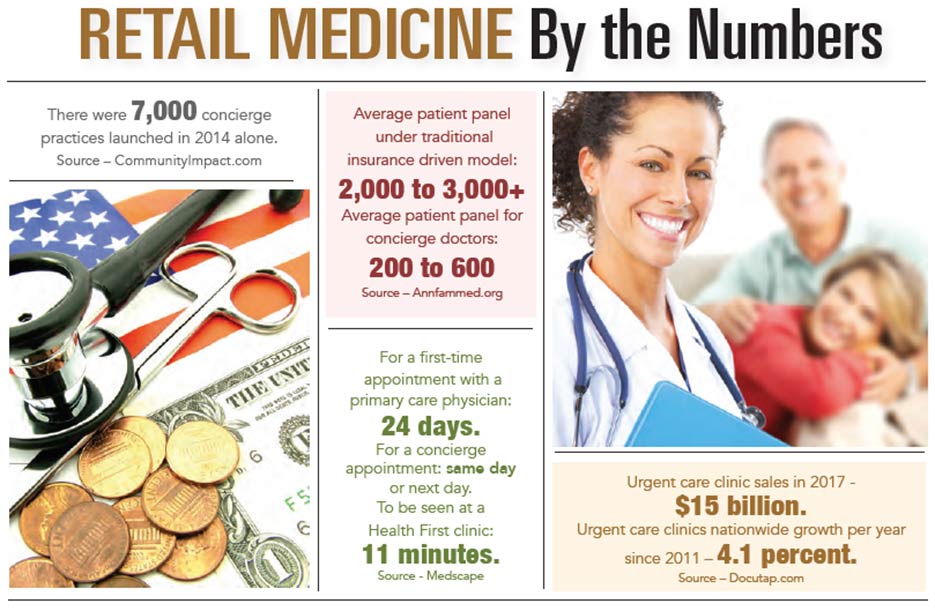What We’re Learning from the Rise of Retail & Concierge Clinics
Neither the rising cost of health care nor the frustratingly long waits for appointments are breaking news to anyone who’s been awake – or sick – in the last decade or two. While many of us in this country are celebrating the newly insured – nearly 20 million since 2010 – we are also experiencing the consequences of the immense spike in demand that it puts on the health care industry on top of the simultaneous influx of aging baby boomers and sheer population growth.
According to Annals of Family Medicine, a primary care physician would have to spend 21.7 hours per day to provide all recommended acute, chronic and preventive care for a panel of 2,500 patients. Today, the most modest estimates have physicians’ patient panels averaging 2,300 and up to well over 3,000 per year or over 30 cases per day. And as the physician shortage stretches doctors ever thinner, our wait times go up and face-to-face interaction goes down. In the last four years alone, new-patient appointment wait times have gone up as much as 30 percent in most major American cities, from an 18-day wait in 2014 to a 24-day wait today.
Two booming business models are answering the call of the weary: retail walk-in clinics and the industry’s fastest growing dark horse – concierge medicine.
About 15 years ago, Dr. David Albenberg opened Charleston’s first and only concierge clinic, although he prefers the term “direct primary care” because his mission is to provide direct, personal and, most importantly, instant access to him and his office, thus the name of his practice: Access Healthcare.
“We try to take the chaos that is health care and create something that is calm and serene and predictable,” he explained.
To that end, the defining aspect of this business model is that he does not accept insurance. By eliminating the stifling expenses, staffing, bureaucratic restrictions and time that insurance filing costs, he is able to eliminate most of the paperwork and streamline the scheduling and payment processes so that he can focus more acutely on personalized care for his patients. His “relationship-based pricing” offers three membership options, from $100 to 200 per month, all of which include same-day or next-day appointments; all routine care, injections and vaccines; urgent care; annual exams; and direct email, phone and even Skype consultations with the doctor. The higher level memberships offer various lab and radiology allowances, 24/7 cellphone access and house calls. And don’t forget the 30-plus patients per day and 2,000 to 3,000-plus patients per year. Access Healthcare currently carries only about 450 patients total.
“We answer the phone, you know who you’re talking to and we know you,” Dr. Albenberg said.
Not surprisingly, direct care practices like his have been flourishing in recent years, although the concierge model is still in relative infancy. The first of its kind opened only 20 years ago in Seattle, and they currently only account for a little over 3 percent of the primary care industry. However, these clinics are proliferating at a rate of between 5 and 20 percent a year depending on the state, growing fastest in major metropolitan areas.
However, the leading alternative to the old school insurance-driven practices are the privately-run retail urgent care clinics, which have matured far beyond the niche market phase, “from $11.8 billion in revenue in 2011 to more than $15 billion in 2017 – 4.1 percent growth per year” according to Markets Insider. These clinics focus more on convenience, speed and savings, or what Frank Wells, CEO of Charleston’s Health First clinics, calls “primary and urgent care for the masses.”
Wells has seen all four of his walk-in primary and urgent care locations in the Charleston area thrive since its inception just 13 years ago. His clinics boast a mere 11-minute average wait time while requiring no appointments, offer convenient hours – 8 a.m. to 8 p.m. every day, including weekends – and multiple low-cost self-pay options including a $97 visit that includes EKGs, X-rays, shots, flu or strep tests plus the doctor visit, diagnosis and prescription writing.
“The only reason we are able to do that,” he explained, “is by eliminating all the inefficiencies and costs we incur in filing claims with insurance companies, not to mention the upfront credentialing, the contracting, the back-end audits, claim submission and software. When we eliminate all those steps from the process, we are able to pass those savings on to the patients and can simply charge them $97 for all of that in a doctor visit.”
So the common thread that unites the two fastest growing health care models is the abandonment of insurance-driven health care in favor of the self-pay consumer-driven model. Wells and Dr. Albenberg aren’t anti health insurance by any means; they just believe that the masses would be better served by catastrophic policies with lower premiums and higher deductibles that would eliminate the insurance overhead for non-catastrophic and wellness care, putting all of that cash back into the hands of the consumers. The problem with that proposal is that the Affordable Care Act does shuns that option. It only allows catastrophic policies for those under 30 or who have hardship exemptions. This is not the only reason, but it’s a big reason why most of our premiums almost doubled under Obamacare. As President Donald Trump himself recently discovered, “Nobody knew that health care could be so complicated,” but here Wells breaks down a big piece of it:
“For a family of four, your out-of-pocket cost for your health insurance is typically $9,000 to $12,000 per year. And it’s really all wellness-focused, plus the surgical/hospital type visits. They’re combined under the same policy because of the ‘Minimal Essential Coverage’ (MEC). If you didn’t have that wellness portion tied to your insurance and you only had the hospital or surgical care insurance, your premiums would drop from $9,000 to $12,000 to one tenth of that! So you could basically have another $8,000 to $10,000 left over to pay for your wellness visits or to make your deductible if you end up in the hospital or in surgery that year. Now you’ve got money left over. But that won’t happen until MEC is separated from the health care requirement law.”
If the success of urgent care and concierge practices is any indicator, a shift toward lower premiums and more self-payments would eliminate most of the endless paperwork and layers of convoluted insurance processing, thus instantly lowering costs for all of us and reducing wait times. Whether policymakers follow suit or not is yet to be seen. But the alternatives to the old way are undoubtedly here to stay. And they may not be mere alternatives for much longer.
By Zach Siders








